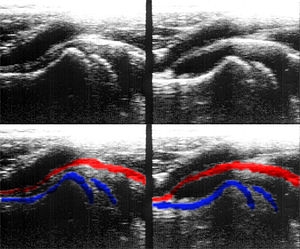Coxitis fugax
| Classification according to ICD-10 | |
|---|---|
| M12.8 | Other specified arthropathies, not elsewhere classified |
| ICD-10 online (WHO version 2019) | |
The transient synovitis , even Hüftschnupfen , coxalgia fugax or transient synovitis called ( ICD-10 : M12.8) is a sterile inflammation of the hip joint is and manifests itself in limp and suddenly occurring in the knee radiating pain. There is a restriction in hip rotation (rotation of the leg in the hip joint). It usually occurs in children or adolescents from three to ten years of age (often boys) and disappears spontaneously within one to two weeks (Latin: fugax = temporarily). Often the coxitis went fugax a viral respiratory - infection ahead. A slight fever and a moderate increase in the rate of sedimentation are possible.
Diagnosis
The diagnosis is confirmed by sonography . The joint effusion in the hip is clearly visible in the picture on the right through the capsule lifted off the bone.
An X-ray is not required to establish the diagnosis, but it can be useful for differential diagnosis : Hip problems in this phase of life always require further observation due to the symptomatic similarity to Perthes disease , adolescent femoral head dissolution and juvenile idiopathic arthritis .
If there is a suspicion, a bacterial (purulent) coxitis should be excluded by puncture . Further studies include inflammation parameters and HLA-B27 .
causes
According to doctors, the cause of coxitis fugax is still unclear. However, it is suspected that there is a connection with an immune reaction of the body following a viral infection of the respiratory tract, for example. Associations with other diseases of the hip, such as hip dysplasia, are medically excluded.
Typical signs of the disease are unilateral pain directly on the hip and groin, as well as externally recognizable "hobbling".
therapy
If the diagnosis is certain, it is enough to take it easy and possibly use a low-dose anti - inflammatory agent - very much in contrast to bacterial coxitis, which usually requires surgical treatment.
With appropriate treatment, doctors estimate the duration of the illness to be a few days. On average, the inflammation and joint effusion heal completely after five to seven days.
history
The runny nose was first described by Robert Williamson Lovett and John Lovett Morse in 1892 . They differentiated the disease from hip joint tuberculosis , as the symptoms lasted well over ten days. They also indicated that a diagnosis would not be made until a few days after symptoms had subsided.
literature
- Carl Joachim Wirth: Orthopedic Practice , Georg Thieme Verlag, Stuttgart / New York, 2001, ISBN 3-13-125683-4
Individual evidence
- ↑ Hip runny nose (Coxitis fugax) - child - diagnosis, symptoms, treatment. Retrieved February 15, 2019 .
- ↑ Günther Brandstetter: Hip runny nose: When walking becomes torture. Orthopedist Dr. An interview with Christof Radler. In: derstandard.at. January 26, 2017, accessed February 15, 2019 .
